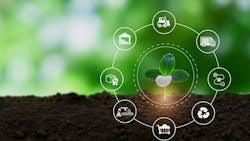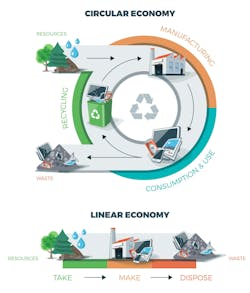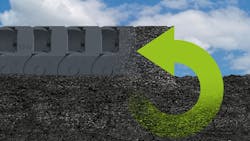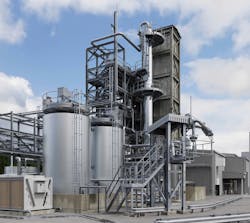Reduce, Reuse and Recycle: 3 Key Facets to a Circular Supply Chain
Creation of a circular supply chain is one of the many methods being employed to improve sustainability.
Unlike traditional supply chains in which materials and goods are produced, consumed and wasted, a circular supply chain aims to reduce waste by using materials and goods as long as possible. This can include the recycling and reuse of materials such as plastics, steel and cardboard as well as the refurbishing of previously owned products. Essentially, a loop is created in which materials and goods are returned to a manufacturer.
Doing so not only helps to lower the number of materials sourced and used in goods production, but also aids with emissions reduction efforts and other sustainability initiatives.
For component manufacturers who are in the early stages of the supply chain, it is important to understand what circularity means from both a customer and regulatory perspective said Zhao Wang, Strategy and Business Development at TE Connectivity, during a panel discussion on circular supply chains which took place as part of the ZAPI GROUP’s Future of Electrification 2024 event.
READ MORE: Electrification Growth Prompts Launch of New Engineering Conference
Understanding these requirements allows the necessary technical aspects to be integrated into the design of a product, she said. “When we talk about circularity and sustainability, in general, it’s about making this planet a better place to live, so we see a lot of requirements from the governmental point of view,” said Wang. “We need to make sure that what we do is compliant with what is being required by national, regional and international [regulations].”
Wang said design considerations for circular supply chains can be categorized into three key areas — reduce, reuse and recycle. “From my point of view, if we really want to look into a circular economy we need take these three points into consideration,” she said.
Following is an outline of what these terms mean to the creation of a circular supply chain and examples of how they are being implemented within various industries.
Circular Supply Chain vs. Circular Economy
The terms ‘circular supply chain’ and ‘circular economy’ are often used when talking about sustainability. So, what exactly do these terms mean and how do they differ from one another, if at all?
Both have to do with prolonging use of materials and goods as long as possible through the principles of reduce, reuse and recycle with the caveat that one applies to the supply chain of a single entity and the other an entire economy.
Circular supply chains can be driven by a manufacturer or other goods producers’ own sustainability goals as well as government regulations while a circular economy is primarily driven by the government. For the latter this can take the form of regulations, incentives for following circular best practices and financial penalties.
1. Reduce Materials and Waste
When talking about the term reduce in relation to circular supply chains, Wang said it is not only about materials but also waste. Materials used in production as well as waste that can occur during each stage of the manufacturing supply chain should be taken into consideration — everything from the raw materials, processing, transportation and more.
There are of course numerous ways materials and waste can be reduced. Technology company igus, for instance, has installed magnetic foils, guide plates and other mechanical devices to prevent parts from falling out of machines during the production process which would otherwise cause them to become waste. According to the company, in 2021 it was able to reduce its waste ratio by 21% because of these devices and other measures taken.
Another potential avenue for reducing materials is the use of additive manufacturing (also referred to as 3D printing). With additive manufacturing, material can be placed only where needed as well as allow for the integration of multiple parts into a single device. Both of these aspects help to reduce the amount of material required for component production. Less machining is also required when utilizing additive manufacturing, offering the potential to reduce energy and waste.
In the article “How 3D Printing Can Drive Us Toward a More Sustainable Future” from Endeavor Business Media partner site Machine Design, it is said that additive manufacturing is a key enabler of a circular economy. This is due to the ability to reuse and recycle materials throughout the process. In addition, this technology allows many to produce a component locally on site, reducing the need for transporting goods.
3D printer manufacturer Desktop Metal Inc. recently announced its qualification of a 100% recycled nickel-based superalloy from Continuum Powders. It is listed as R&D Qualified in the company's binder jet 3D printing portfolio and can be used for applications requiring high strength at temperatures up to 1,000 C.
“The fact that we’re seeing reclaimed metal powders validated by Desktop Metal, along with other leading AM (additive manufacturing) OEMs, signals that these materials are now a proven resource for manufacturers,” said Continuum Powders’ CEO Rob Higby in the press release announcing Desktop Metal's qualification of its powder. “Use of recycled powders can shorten supply chains, reduce costs and support corporate goals for carbon footprint reduction.”
2. Reuse What is Feasible
In terms of reuse, Wang said it is important to think about the second life of a product. For goods such as clothing and plastic bottles, there are many ways items like these can be reused such as reselling clothes or turning plastic bottles into other products.
But for components used in mobile and industrial machinery, she said a more detailed study is required to determine exactly how reuse will occur. “Is it about how we reuse materials? Is it about how we reuse scraps? Or is it about how we reuse the product when it goes into customers’ products?” said Wang.
This is an area in which igus is investing its resources as well by working to reuse materials when possible. Per the company, 99% of the rejected materials from its injection molding production are recycled and returned to the manufacturing process. Reusing materials in this manner minimizes the amount of raw material required for its component designs as well as the transport of them to igus’ various facilities.
Electric vehicle batteries are a component which often comes to mind when discussing reuse. Once past their useful life, there is the potential for utilizing batteries for energy storage or other applications. However, there are some challenges associated with second-life batteries (as they are referred to) noted Trevor Steele, Business Development Manager at Stafl Systems — a developer of lithium-ion batteries — during the circular supply chain panel discussion.
“In a lot of cases, we don’t understand how that battery was used,” he said. Typically, there is no information available on whether the battery was abused in some way which is critical to know in a second-life application.
“There should be some technology coming out in the next few years that should help with that, but for right now second life is more limited because we don’t have that history of use [information],” said Steele.
READ MORE: Getting Connected to Sustainability
3. Recycle Throughout the Value Chain
Recycling can come in many forms as well. From TE Connectivity’s perspective, Wang said it includes reusing raw materials or scraps as well as the collection of waste heat generated during manufacturing which is then used to heat office buildings.
Here again igus is making major investments. In 2022, the company introduced its first e-chain cable carrier made from 100% recycled materials which features the same wear behavior, stability and bending fatigue as conventional versions. The company offers various other components made from recycled materials as well.
READ MORE: igus Unveils Bike Made from Recycled Plastic
The company has also established the chainge recycling program which allows customers to turn in old cable carriers — which can be from igus or other manufacturers — for recycling; customers receive a voucher for the purchase of new igus products. As of December 2021, the company states on its website it has received 25.97 tons of material.
Additionally, igus is investing in companies that can aid its recycling efforts. One such company is Mura Technology which has developed a plastics recycling plant known as the Hydrothermal Plastic Recycling Solution (HydroPRS). The plant uses only pressure, heat and water to turn plastic waste back into oil within 30 minutes. This oil can then be used to produce new plastics and other products.
Per an igus press release on the commissioning of the HydroPRS plant, independent life-cycle analyses by WMG at the University of Warwick have shown that carbon dioxide (CO2) emissions are 80% lower than with combustion. When compared to fossil oil-based raw materials, the HydroPRS plant is able to offer products with equivalent or lower global warming potential and save up to around 5 barrels of oil for every tonne of plastic waste processed.
“This technology is a real game changer in plastics recycling,” said igus CEO Frank Blase.
When developing its Air-X filter technology for use with hydraulic reservoirs, a key aspect for HYDAC International was to use materials which could be recycled. Filters are a component which need to routinely be replaced due to the nature of their job — capturing contaminants — leading to them being thrown out.
To help mitigate the waste associated with frequent filter replacements, HYDAC chose to use plastic and aluminum for the cartridge used in its filter as they are both recyclable materials. According to the company, its goal was to develop a filter containing as many core components as possible which could be reused.
As resources become scarcer and concerns over environmental impacts from emissions and other byproducts of goods production increase, establishing circular supply chains offer the potential to help mitigate these issues and create a more sustainable future.
About the Author
Sara Jensen
Executive Editor, Power & Motion
Sara Jensen is executive editor of Power & Motion, directing expanded coverage into the modern fluid power space, as well as mechatronic and smart technologies. She has over 15 years of publishing experience. Prior to Power & Motion she spent 11 years with a trade publication for engineers of heavy-duty equipment, the last 3 of which were as the editor and brand lead. Over the course of her time in the B2B industry, Sara has gained an extensive knowledge of various heavy-duty equipment industries — including construction, agriculture, mining and on-road trucks —along with the systems and market trends which impact them such as fluid power and electronic motion control technologies.
You can follow Sara and Power & Motion via the following social media handles:
X (formerly Twitter): @TechnlgyEditor and @PowerMotionTech
LinkedIn: @SaraJensen and @Power&Motion
Facebook: @PowerMotionTech

Leaders relevant to this article:






